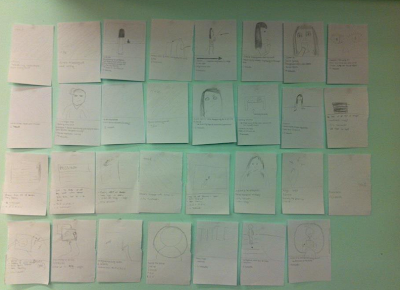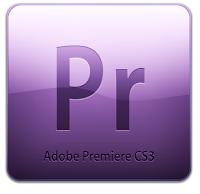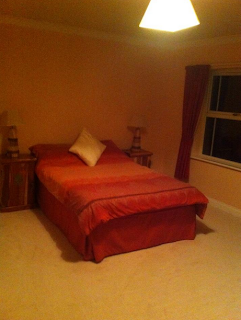In the extract from Hotel Babylon the director represents many stereotypical and atypical constructions of ethnic groups, some of which may be considered and interpreted as negative. The extract opens with a wide shot whilst tracking right, this is significant because it helps the audience recognise the mise-en-scene and body gestures within the extract. The man is wearing a suit with connotes his high social status - the side view helps the audience notice the man brushing his suit down, indicating he is proud of where he works. The extract then goes onto a mid shot of two black men. One of which is portrayed as a stereotypical Jamaican man, the fact that the man has dreadlocks and no top is iconic of the culture. The over the shoulder shot of each of the characters emphasises the juxtaposition between the two opposing men, it also helps the audience see the reaction of each of the characters. The eye line match reinforce the idea of the characters being equal as the are audience are frequently viewing the two characters at the same level, physically. Each of the men have the same amount of screen time, demonstrating the balance in equality between the two characters. It is evident to the audience they have the same ethnicity due to the diegetic sound of them talking about memories and the colour of their skin which denotes that the ethnicity is the same. Furthermore, the diagetic sound such as the dialogue convey how the upper class man is speaking standard English, however, the Jamaican man is speaking colloquial language. The significance of the two characters being the same sex displays how the gender within the ethnicity can be represented differently.
The extract then goes onto the representation of two Eastern European hotel maids. When introducing the characters, their is a lack of cuts displaying slow paced shots. This reveals to the audience the facial expression of one of the maids, looking anxious and worried. The high key lighting contrasts with her mood due to the setting being vibrant. Also, this is significant due to the atypical representation of one of the maids which juxtaposes with other stereotypically Eastern European maid who is portrayed as a more traditional stereotype of an Eastern European. This is evident to the audience through the diagetic sound such as the dialogue when she states “double for double”, revealing to the audience the idea of prostitution. The gender is also considerably important as the two characters are women, who of which are considered higher in prostitution. The non diagetic sound is parallel as the music is upbeat which sets a seductive mood throughout the scene, giving the reader a more advanced insight on the stereotypical Eastern European women. The long shot of the two maids stripping reinforces and emphasises the stereotypical culture which has been representation in an arguably negative way due to the abundance of the prostitution in Eastern European. The editing such as the shot reverse shot displays to the audience the facial expression on the Chinese man which expresses desire and desperation, representing a stereotypical Chinese businessman. The mise-en-scene reinforce the stereotypical representation as he is wearing a dressing gown, connoting he is used to the luxury lifestyle, representing his culture as wealthy.
Moreover, the ethnicity of the English culture is represented as dominant. The two English managers are introduced with a long shot, revealing the classy, sophisticated costume which signifies that they are of high power. The long shot also displays the surroundings of other characters which are portrayed as a lower status as they remove themselves from the area of which the English managers are walking through. This denotes to the audience that the English people are being represented in a stereotypical way as they seem to control the surroundings and have the power to remove characters when they are in the scene. The two characters are centralised throughout the scene, reiterating the focus on the English characters. The significance of using a male and female to represent the stereotypical English people denote that the genders are equal in the ethnicity. The diagetic ambient sound in the background helps make the scene look authentic and as there is a lot of distraction in the background, but the main focus is still on the two English people, emphasising the dominant state of power in roles which they have. The use of the diagetic sound such as the dialogue reveals to the audience that they are higher class in society as the use of standard English is frequently used throughout.
Furthermore, the opening long shot of the two chefs is significant as it reveals the two opposing ethnicities, one of which is is from Eastern Europe and the other from England. The mise-en-scene such as the costume convey the equality between both of the men as they have are employed as the same position which are chefs. However, the use of the binary opposition of the colour of clothing contradicts this as the Eastern european man is wearing darker colour clothing, signifying a dark side to the him and the representation of the culture. However, the Englishman is wearing a full white coloured clothing signifying purity and lack of immorality. The use of the props such as the food and cooking tools help the scene look authentic and reinforce the idea of them both working in the same job despite the different ethnicity. It is evident to the audience that one of the chefs are represented as a stereotypical Englishman, as the diagetic sound such as the dialogue reveals to the audience the use of standard english being frequently used. The second chef is introduced in a negative way due to the recurring mid shots which display his violent body gestures, representing the ethnicity of Eastern Europe as negative. The non diagetic sound is parallel as it creates tension and symbolises the frustrated feelings which both of the characters are portrayed to have. The folly diagetic sound of the knife being pulled out by the Eastern European and the close up of the Englishman looking anxious infer that the Eastern European man is in higher control which contradicts with the previous representations of them being equal.
Overall, the extract successfully displays a group of different ethnicities in a partly stereotypical way. The use of the opposing characters in the various ethnicity such as the Jamaican man and the second maid restrict the stereotyped being represented throughout. However, the director has given the audience an insight on the basic culture of each ethnicity which all could be arguably interpreted negative or positive.
By picking out and analysing the key techniques from the extract it helps me understand the affect of the technical techniques which will help me when coming to filming my coursework piece as I already have a brief outline of what the camera, mise-en-scene, editing and sound do within a piece.













